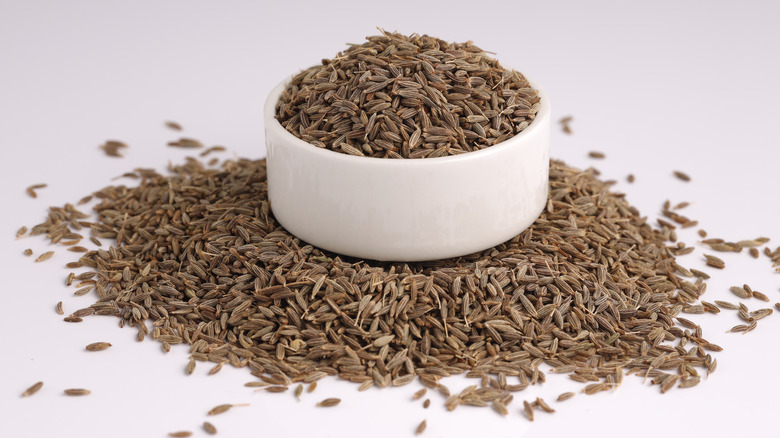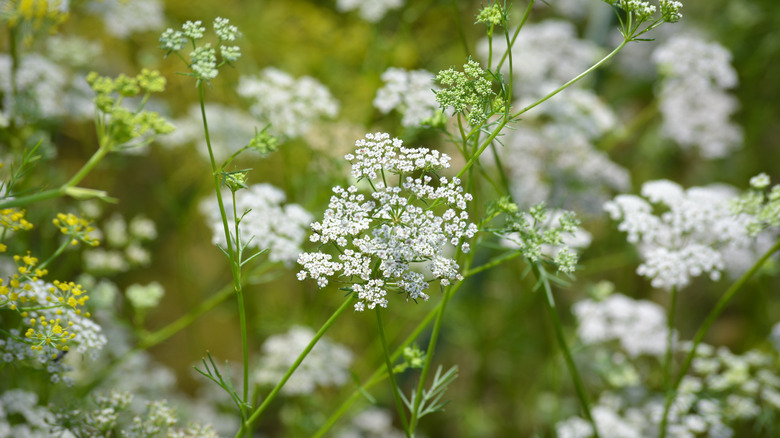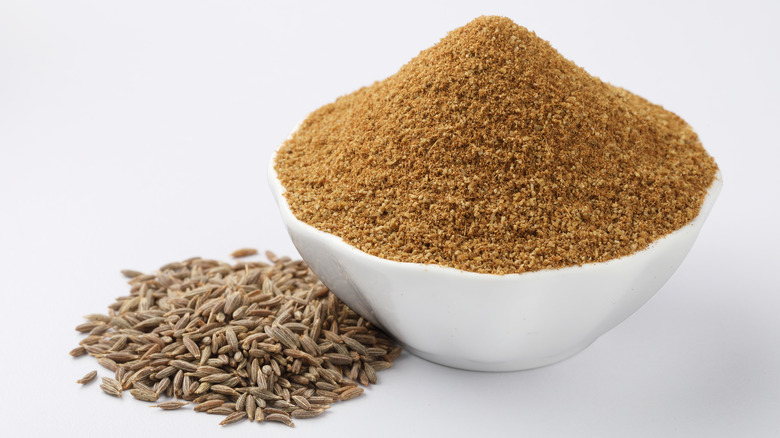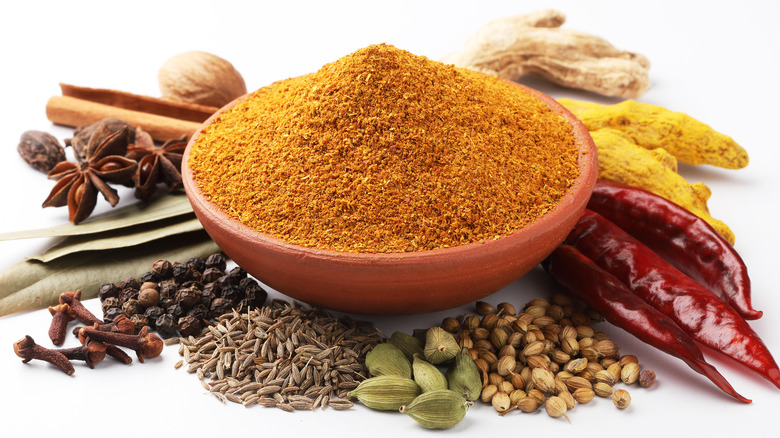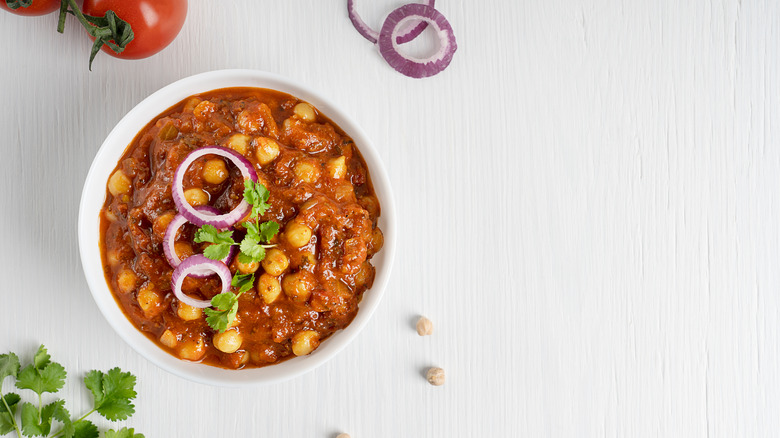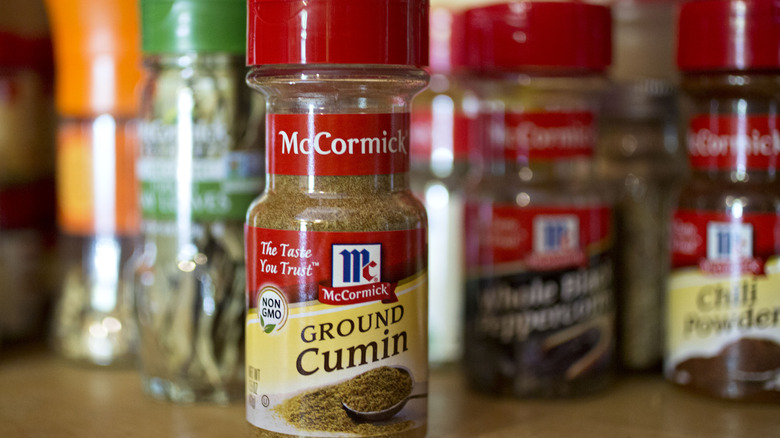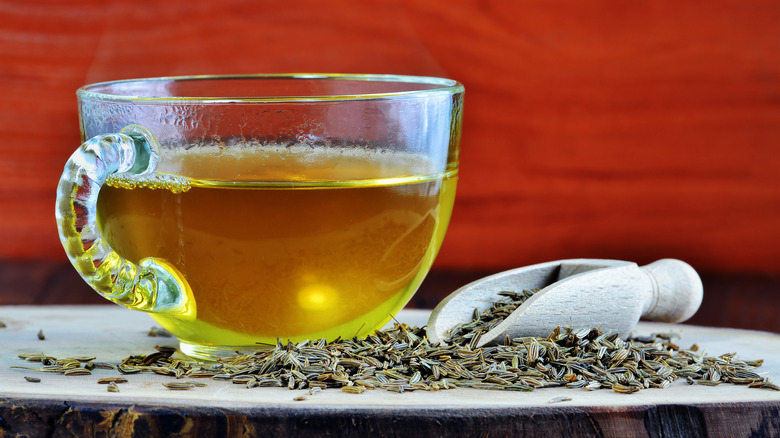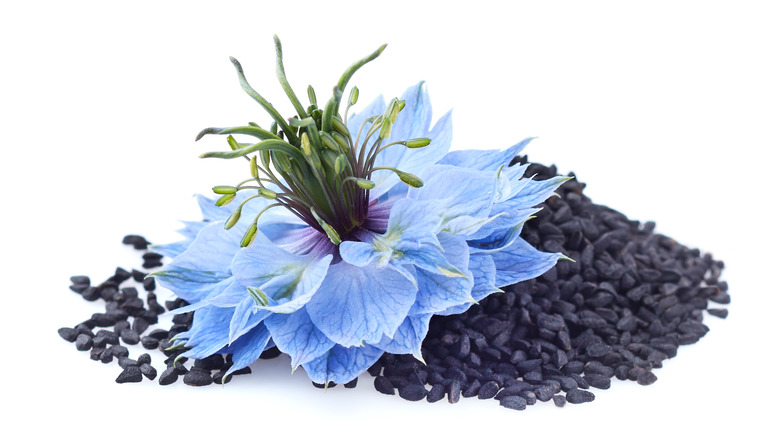What Is Cumin And Is It Spicy?
Cumin is a spice you may be familiar with if you've ever made chili. And if you've done much Mexican or Middle Eastern cooking or whipped up a South Asian-style curry, you've also probably used cumin alone or as part of a spice blend such as garam masala. While Forbes says that cumin is becoming rather trendy these days as our palates continue to go global, this seasoning has been known since ancient times.
Cumin was used by the ancient Egyptians some 5,000 years ago, and The Epicentre says that cumin seeds have been found in the Old Kingdom pyramids. Tablespoon goes on to reveal that cumin was even put to use during the mummification process. The ancient Greeks and Romans made use of cumin as well, for both medicinal and cosmetic purposes, while it seems to have been quite common in the Middle East during Biblical times. In fact, OpenBible lists some 100 Bible verses making mention of this seasoning, including this insightful peep into early methods of cultivation from Isaiah 28:27: "Dill is not threshed with a threshing sledge, nor is a cart wheel rolled over cumin, but dill is beaten out with a stick, and cumin with a rod." Who knew? During the Middle Ages in Europe, the crusaders brought cumin back from the Middle East, and it became popular there, says Épices Rœllinger. In later years, Spanish ships brought cumin to the Americas.
What is cumin?
Cumin comes from the seeds of the Cuminum cyminum plant, which SPICEography explains is in the parsley family. This plant is cultivated in North Africa, the Americas, throughout the Mediterranean, China, and India. This last-named location is the source of over 50% of most commercially available cumin today, but cumin may have first been grown in Egypt's Nile Valley, per Savory Spice. One legend has it that cumin takes its name from the island of Comino, which is near Malta, but the name is actually Hebraic in origin (via Épices Rœllinger).
As far as their looks, the most commonly used cumin seeds are about ¼-inch long and brown-gray in color, but black, green, and white seeds also exist, says Rumi Spice. The seeds are picked, sun-dried and/or ground, and stored, as they are not typically used in their fresh form. Cumin seeds bear a strong resemblance to those of caraway (a close relative) with two key differences: Cumin seeds are paler and appear to be divided into two sections, while caraway seeds do not. Still, you'll need pretty sharp eyes to tell them apart, so it's probably a good idea not to store them right next to each other in unlabeled jars.
Ground cumin vs cumin seeds
Cumin is available in two varieties: whole seeds and ground. It's the exact same spice, it's just that ground cumin is made from cumin seeds that have been, well, ground. SPICEography tells us that the difference in flavor between the two types of cumin is that the process of grinding releases flavor compounds, so ground cumin tends to be more pungent. The problem, however, is that ground cumin also tends to lose its flavor more quickly than the whole seeds do, so keep that in mind when buying and storing the spice. Ideally, if you want the most flavorful cumin, you'd buy the seeds and then use a spice grinder to grind just as much cumin powder as you need for a recipe right before you use it.
When you are cooking with cumin, the ground stuff can be added to a dish at any point, since it does not need heat to disperse its flavor. Whole seeds, however, should be added early on in the cooking process and either sautéed in hot oil, simmered in broth, or toasted in order to impart their full flavor. As ground cumin has a more intense, concentrated taste than cumin seeds, if you're substituting it for the seeds in a recipe, you'll need to cut down the amount just a bit; The Spruce Eats suggests using 1 tablespoon of ground cumin in place of 1 ¼ tablespoon of cumin seeds, and vice-versa.
What does cumin taste like?
Cumin has an overall warm, hearty, and earthy flavor with a hint of sweetness and citrusy freshness. While it's often used in heavily spiced dishes, cumin itself isn't actually all that spicy hot. The Epicentre rates it a three on the heat scale, whereas it gives cayenne an eight or nine and habanero peppers a 10 on another list. By these same standards, cumin has slightly more heat than paprika and about the same heat level as an Anaheim pepper.
Not everyone is a big cumin fan. One commenter in a DC Urban Moms and Dads thread about most-disliked spices described the spice as something that "smells like sweaty feet," while someone on a Reddit cooking thread said "cheap cumin" tastes like body odor and is best when bought in higher quality. Another person, apparently on the fence about this divisive spice, contributed, "I think it smells a bit like an armpit but not in an entirely negative way?" Let's just agree to let everyone like or dislike the spice on their own, shall we? If you already know and loathe cumin, however, another Redditor suggests using smoked paprika mixed with dark chili powder as a less controversial-smelling substitute.
How to cook with cumin
Cumin is one of the spices used to make both chili powder and taco seasoning, so it is frequently associated with Mexican cooking. The Spruce Eats notes that it also features prominently in Middle Eastern cuisine, where it pairs well with lamb and beef as well as in vegetable dishes involving lentils, chickpeas, and eggplant. In Indian cooking, cumin features in a number of spice blends and may be paired with other seasonings including chiles, mustard seeds, turmeric, coriander, and peppercorns. Cumin, in conjunction with these other spices, is used to make both curries and chutneys. Try it in sauces, soups, stews, and just about anything containing meat.
While cumin isn't typically used in sweet dishes, some adventurous cooks have tried it in dessert recipes. Home Stratosphere suggests it is best when paired with baked pears, apples, and other fruits and works well with both cinnamon and cloves. If you really want to think outside the spice cabinet, though, Great British Chefs has a recipe for a chocolate-cumin fudge.
Where to buy cumin
Cumin is considered to be a pretty mainstream spice, so much so that it is often included on lists of must-have spices and found in starter spice packs, such as one from Amazon. As such, it can be purchased in almost any grocery store and is likely to be found in the spice aisle. Start by looking for it between coriander and curry powder if your supermarket arranges its spices in alphabetical order.
Rumi Spice suggests that you only buy cumin from grocers who restock their spices on a regular basis, as old cumin is likely to lose its flavor the longer it sits on a store shelf. Another cumin shopping tip is to check the expiration date. Obviously, you don't want to buy anything that is close to expiring (much less past its sell-by date), but on the other hand, if the cumin you buy claims to stay fresh for 3-plus years, this might indicate a certain lack of quality control on the part of the supplier.
Nutritional information about cumin
Considering that cumin is a spice, it's not something you're likely to consume in large quantities — at least not in one sitting. As such, it likely won't contribute too much to your daily calorie count, nor is it likely provide too many of your regular nutrients. According to Nutrition Data, a full tablespoon of cumin (more than might be used to flavor an entire pot of chili or curry) has about 23 calories, 3 grams of carbohydrates, and 1 gram of fat, while providing just 1 gram of protein. Should you manage to consume an entire tablespoon of cumin in a day, you will at least have taken in 10% of your daily recommended manganese and 22% of your necessary iron.
Healthline notes, however, that cumin does offer certain health benefits, at least in its concentrated supplement form. It can help with digestion and was even shown to reduce symptoms of irritable bowel syndrome in one study. It may also help with managing diabetes, lowering blood cholesterol, and weight loss, at least if taken as a dietary supplement. Cumin also has antimicrobial properties that may prevent food poisoning.
Other varieties of cumin
According to Home Stratosphere, there are actually five different varieties of cumin. Plain old cumin, the kind we've been discussing here, is yellowish-grayish brown in color. Black cumin, which is, you guessed it, black in color, is actually a different species called Nigella sativa. It is said to be both sweeter and tangier than cumin, with a flavor somewhat reminiscent of caraway seeds. Brown cumin is often used in Indian and North African cooking, while bitter cumin — known as Cuminum nigrum or Bunium persicum — is commonly consumed in Northern India.
White cumin is the fifth type, which has a warm and bitter flavor, and Rumi Spice actually names another variety called green cumin. A study performed at Sudan's Shendi University (via ResearchGate) names these as belonging to the species Cuminum cyminum, which is just the scientific name for ordinary cumin. Different recipes may call for these more specific varieties of cumin, but when in doubt, just use the kind you can find.
